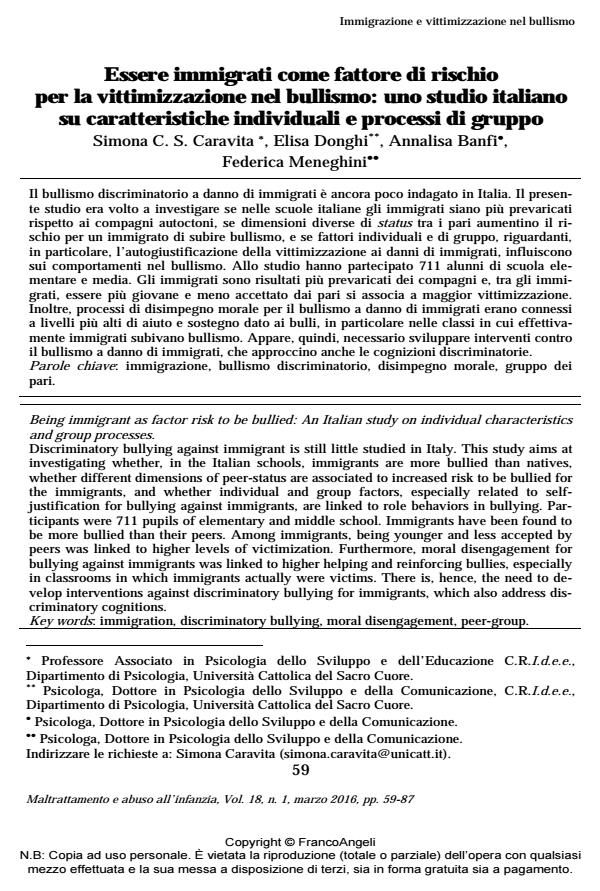Being immigrant as factor risk to be bullied: An Italian study on individual characteristics and group processes
Journal title MALTRATTAMENTO E ABUSO ALL’INFANZIA
Author/s Simona C. S. Caravita, Elisa Donghi, Annalisa Banfi, Federica Meneghini
Publishing Year 2016 Issue 2016/1
Language Italian Pages 29 P. 59-87 File size 192 KB
DOI 10.3280/MAL2016-001004
DOI is like a bar code for intellectual property: to have more infomation
click here
Below, you can see the article first page
If you want to buy this article in PDF format, you can do it, following the instructions to buy download credits

FrancoAngeli is member of Publishers International Linking Association, Inc (PILA), a not-for-profit association which run the CrossRef service enabling links to and from online scholarly content.
Discriminatory bullying against immigrant is still little studied in Italy. This study aims at investigating whether, in the Italian schools, immigrants are more bullied than natives, whether different dimensions of peer-status are associated to increased risk to be bullied for the immigrants, and whether individual and group factors, especially related to selfjustification for bullying against immigrants, are linked to role behaviors in bullying. Participants were 711 pupils of elementary and middle school. Immigrants have been found to be more bullied than their peers. Among immigrants, being younger and less accepted by peers was linked to higher levels of victimization. Furthermore, moral disengagement for bullying against immigrants was linked to higher helping and reinforcing bullies, especially in classrooms in which immigrants actually were victims. There is, hence, the need to develop interventions against discriminatory bullying for immigrants, which also address discriminatory cognitions.
Keywords: Immigration, discriminatory bullying, moral disengagement, peer-group.
- Prejudice and Ethnic Bullying Among Children: The Role of Moral Disengagement and Student-Teacher Relationship Nicolò Maria Iannello, Marina Camodeca, Carmen Gelati, Noemi Papotti, in Frontiers in Psychology 713081/2021
DOI: 10.3389/fpsyg.2021.713081 - Attraverso le sofferenze della vittima: tra bullismo, cyberbullismo e proposte di intervento Serena Dimitri, Sofia Pedroni, Elisa Donghi, in MALTRATTAMENTO E ABUSO ALL'INFANZIA 1/2018 pp.31
DOI: 10.3280/MAL2018-001003 - “Judging by the cover”: A grounded theory study of bullying towards same-country and immigrant peers Angela Mazzone, Robert Thornberg, Sara Stefanelli, Livia Cadei, Simona C.S. Caravita, in Children and Youth Services Review /2018 pp.403
DOI: 10.1016/j.childyouth.2018.06.029 - Skin color discrimination among primary school children Margherita Cardellini, in MALTRATTAMENTO E ABUSO ALL'INFANZIA 3/2018 pp.93
DOI: 10.3280/MAL2018-003006 - The Wiley Blackwell Handbook of Bullying Hildegunn Fandrem, Dagmar Strohmeier, Simona C. S. Caravita, Elisabeth Stefanek, pp.361 (ISBN:9781118482728)
- Psychometric properties of the Centrality of Event Scale in Italian adolescents Chiara Ionio, Eleonora Mascheroni, Paola Di Blasio, in MALTRATTAMENTO E ABUSO ALL'INFANZIA 1/2018 pp.67
DOI: 10.3280/MAL2018-001005 - Bullismo etnico: chi sono coloro che aggrediscono compagni con background migratorio? Noemi Papotti, Simona Carla Silvia Caravita, in RICERCHE DI PSICOLOGIA 1/2020 pp.327
DOI: 10.3280/RIP2020-001015 - Il funzionamento morale come fattore di rischio per il bullismo e il cyberbullismo Simona C. S. Caravita, Luca Milani, Giulia Binaghi, Cristiana Apolloni, in MALTRATTAMENTO E ABUSO ALL'INFANZIA 1/2018 pp.47
DOI: 10.3280/MAL2018-001004 - Mani che parlano: un'esperienza laboratoriale per "ricucire" le emozioni della propria storia Cecilia Ragaini, Angela Gammarano, Francesca Cerutti, Alessia Zangari, Federica Bianchi, Martina Branca, in MALTRATTAMENTO E ABUSO ALL'INFANZIA 1/2018 pp.93
DOI: 10.3280/MAL2018-001007 - When the bullied peer is native‐born vs. immigrant: A mixed‐method study with a sample of native‐born and immigrant adolescents Simona C. S. Caravita, Sara Stefanelli, Angela Mazzone, Livia Cadei, Robert Thornberg, Barbara Ambrosini, in Scandinavian Journal of Psychology /2020 pp.97
DOI: 10.1111/sjop.12565 - Comparison of levels of bullying, achievement motivation, and resilience among Syrian refugee students and Turkish students Mehmet Akif Karaman, in Journal of Psychologists and Counsellors in Schools /2023 pp.62
DOI: 10.1017/jgc.2021.22
Simona C. S. Caravita, Elisa Donghi, Annalisa Banfi, Federica Meneghini, Essere immigrati come fattore di rischio per la vittimizzazione nel bullismo: uno studio italiano su caratteristiche individuali e processi di gruppo in "MALTRATTAMENTO E ABUSO ALL’INFANZIA" 1/2016, pp 59-87, DOI: 10.3280/MAL2016-001004